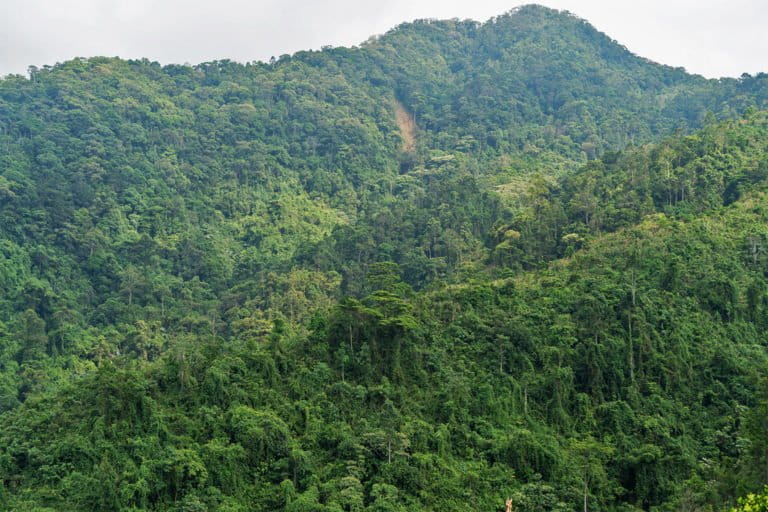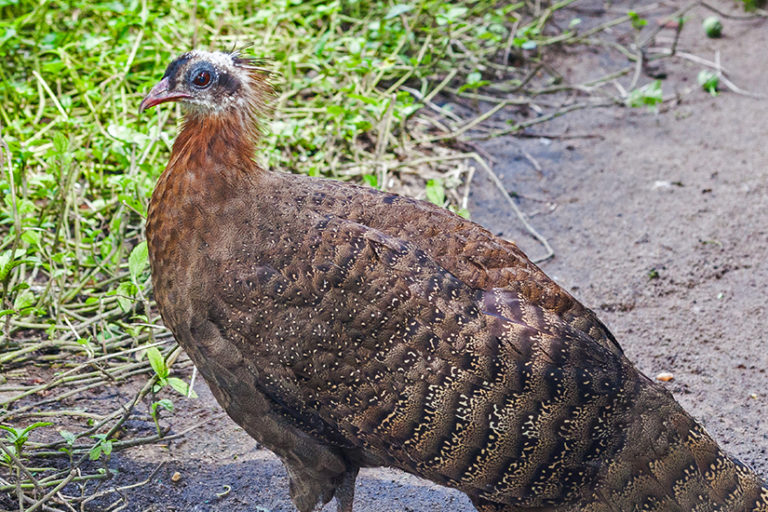- Camera traps recently captured images of several highly endangered species in Phong Dien Nature Reserve in Vietnam.
- These include the Annamite striped rabbit (Nesolagus timminsi) and Owston palm civet (Chrotogale owstoni), which are only found in the Annamese range of Laos and Vietnam.
- The observations confirmed the high biodiversity value of Phong Dien and the importance of strengthening protection against threats such as trap hunting and hydropower development.
HO CHI MINH CITY – Camera traps placed in a remote nature reserve in central Vietnam recently captured images of rare muntjac deer, in addition to a number of other endangered species, raising hopes over the state of biodiversity there.
The sightings took place in the Phong Dien Nature Reserve in Thua Thien-Hue Province, a rugged part of the Truong Son Mountains (known internationally as the Annamites) near the Vietnamese border with Laos.
Local media reported that 110 cameras had been placed by the reserve management board and staff of conservation NGO Viet Nature in an attempt to capture the extremely rare Edwards’ pheasant (Lophura edwardsi).
Instead, cameras took photos of two muntjacs, as well as around 30 species of birds and mammals such as the crested argus (Rheinardia ocellata), Annamese striped rabbit (Nesolagus timminsi) and Owston palm civet (Chrotogale owstoni).
Although the precise species of muntjac has not yet been officially announced, experts at the Saola Foundation for Annamite Mountains Conservation say it could be Roosevelt’s muntjac (Muntiacus rooseveltorum).
Regardless of the species, the fact that they have been spotted on camera is promising.
“Camera traps are actually a very inefficient way to detect very low density species,†said Lorrain Scotson, CEO ex officio of the Saola Foundation. “You put a camera on a tree and you have to trust not only the passing animal, but also the batteries that don’t die, the camera is not drowned, the image is not blurry; there are so many ways a camera trap can fail, and only one way to succeed. So if an animal is detected on a camera trap, that’s the tip of the iceberg – it means the population is at a density high enough to be captured, so that’s very encouraging.
Viet Nature could not be reached for comment prior to publication.
Sightings of muntjacs and other wildlife further underscore the importance of this nature reserve for the biodiversity of central Vietnam and neighboring regions of Laos.
“Phong Dien remains a priority area for investment in the Central Annamese landscape as it still maintains populations of endemic and threatened species, while being important for the connectivity of the landscape forests,†said Ben Rawson, director of conservation and program development at WWF -Vietnam. “During an intensive camera trapping carried out in 2018, several species that were not detected at other sites were detected at Phong Dien, which suggests that additional investment in the site would be valuable, despite the vagaries of detection. “
The nature reserve was established on November 13, 2002 and covers 40,815 hectares (100,856 acres), of which 28,054 hectares (69,323 acres) are strictly protected from all human activity, according to a fact sheet from the USAID on Phong Dien.
The reserve was originally created in response to the 1996 rediscovery of Edwards’ pheasant, which had been considered possibly extinct until then. However, no other living specimens have been seen since, and the only more recent record was a 2018 photo of a dead female Edwards’ pheasant in the A Luoi district, which includes part of the reserve.

A total of 38 species of mammals, 204 species of birds, 35 species of reptiles and amphibians and 755 species of plants have been described in the reserve, many of which face a high risk of extinction, according to USAID. . Owston’s civet and Annamese striped rabbit are only found in these mountains, and their presence gives Phong Dien additional significance.
Due to the absence of confirmed reports of Edwards’ pheasants since 1996, the species is not included in this list.
As with any protected area in Vietnam, persistent threats remain to both forest health and biodiversity.
“Wildlife surveys conducted by WWF in 2018 showed that snaring hunting is still a major threat, as is the case in most of the region’s protected areas,†Rawson said. “This threat has resulted in the depletion of populations of terrestrial wildlife susceptible to this type of hunting.”
Habitat fragmentation is also a concern, especially in river valleys, he added.
USAID notes that the development of hydropower, which is common in the mountainous regions of Vietnam, also poses a lasting threat to conservation: “Cleaning up habitats, developing infrastructure and hunting and consuming wildlife. by the construction teams all contribute to having an impact on the values ​​of the site â€.
Observations of camera traps should receive increased attention from conservation groups and the Phong Dien management team with the aim of confirming the presence of these species and ensuring their protection.


“After some positive wildlife surveys in 2018, WWF-Vietnam will increase its technical support to improve the management of the protected area over the next few years,†said Rawson. “We hope that with improved management and support for the livelihoods of local communities, we will see wildlife populations begin to recover.”
Scotson said she hoped such findings would make the general public more aware of this ecologically critical region.
“I draw attention to the Annamese, who really look like the unfamiliar Amazon rainforest of Southeast Asia,†she said. “Very few people have heard of it. The images are therefore extremely useful for awareness raising, and if anyone sees an Annamese striped rabbit on the BBC, it will stick with them.

